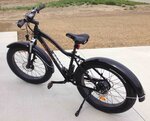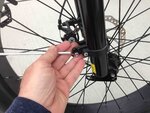Today I went on a 10.4 mile ride (5.2 miles each way). That completes the first 100 miles on the RadRover! It was fun however there are a few things I wanted to write here:
1. Gearing - I have tried all levels of assist and noticed that in PAS level 5, at almost 20+ mph, its not very easy to pedal in the 7th gear. I really wish it was a 9 speed or more. Perhaps I am not used to pedaling that fast but once I go to PAS level 5, 7th gear is not good enough for me to maintain the speed on a level road. Just cant pedal that fast. I wonder if it is possible to replace the cassette to one that has more gears?
2. Weight ratio - In my limited trail rides I discovered that the weight is perhaps more focused towards the rear. I should prove it scientifically but for now, that is the way I feel. So far twice while I was going up a steep hill (exact same hill both times) the front wheel came up and I had to get down else I would have tumbled down along with the radrover. Google says the elevation was 15.9% (36 feet elevation gain over 220 feet distance). The first time, I didnt know what to expect. The second time, I was prepared and was in a lower gear but it still did that. Both times, the front wheel came up when I stood up on the pedals. I am going to give it one more try tomorrow and see if I can get up the hill without standing on the pedals and lifting the bike up.
3. Battery Indicator - In the area we live, we have quite a few ups and down. Any route I take, its the same thing. The first few miles I was riding in PAS 2/3 but recently I have started riding more in PAS level 4. I dont like to ride in PAS level 5 due to the gearing. I have noticed that after putting about 10 miles in PAS 4, the battery drops 2 bars after letting in stand by for about 10 minutes. But then you switch the bike off and come back an hour or more later, it now shows only 1 bar used. Based on that I am not sure how long this will go in PAS level 4. I am going to go on another ride tomorrow morning - 17 miles round trip. Will see how it fares.
4. Rear brake squeeking - that rear disc just bothers me. Its loud and not sure what to do about it. I am going to do some cleaning of the rotor and see if that goes away.
5. Fenders - I have ridden in the rain, on wet roads (while not raining) and on dry roads. With the small fenders that came with the bike, it is impossible to ride on wet roads. I need to get the full fenders which I think are over priced at $159 for the set which is more than 10% of the cost of the bike. It should have come with the bike in the first place since its unusable without it excepting in dry weather conditions.
But other than these, it is a lot of fun to ride the RadRover. I love it. The front suspension seems to be decent and the tires seem to be absorbing most of the vibrations and the jerks. Going up and down the pavements is a piece of cake compared to my road bike. Going trail riding is a lot of fun although a full suspension would have been better.
Any suggestions?
Thanks for reading!
1. Gearing - I have tried all levels of assist and noticed that in PAS level 5, at almost 20+ mph, its not very easy to pedal in the 7th gear. I really wish it was a 9 speed or more. Perhaps I am not used to pedaling that fast but once I go to PAS level 5, 7th gear is not good enough for me to maintain the speed on a level road. Just cant pedal that fast. I wonder if it is possible to replace the cassette to one that has more gears?
2. Weight ratio - In my limited trail rides I discovered that the weight is perhaps more focused towards the rear. I should prove it scientifically but for now, that is the way I feel. So far twice while I was going up a steep hill (exact same hill both times) the front wheel came up and I had to get down else I would have tumbled down along with the radrover. Google says the elevation was 15.9% (36 feet elevation gain over 220 feet distance). The first time, I didnt know what to expect. The second time, I was prepared and was in a lower gear but it still did that. Both times, the front wheel came up when I stood up on the pedals. I am going to give it one more try tomorrow and see if I can get up the hill without standing on the pedals and lifting the bike up.
3. Battery Indicator - In the area we live, we have quite a few ups and down. Any route I take, its the same thing. The first few miles I was riding in PAS 2/3 but recently I have started riding more in PAS level 4. I dont like to ride in PAS level 5 due to the gearing. I have noticed that after putting about 10 miles in PAS 4, the battery drops 2 bars after letting in stand by for about 10 minutes. But then you switch the bike off and come back an hour or more later, it now shows only 1 bar used. Based on that I am not sure how long this will go in PAS level 4. I am going to go on another ride tomorrow morning - 17 miles round trip. Will see how it fares.
4. Rear brake squeeking - that rear disc just bothers me. Its loud and not sure what to do about it. I am going to do some cleaning of the rotor and see if that goes away.
5. Fenders - I have ridden in the rain, on wet roads (while not raining) and on dry roads. With the small fenders that came with the bike, it is impossible to ride on wet roads. I need to get the full fenders which I think are over priced at $159 for the set which is more than 10% of the cost of the bike. It should have come with the bike in the first place since its unusable without it excepting in dry weather conditions.
But other than these, it is a lot of fun to ride the RadRover. I love it. The front suspension seems to be decent and the tires seem to be absorbing most of the vibrations and the jerks. Going up and down the pavements is a piece of cake compared to my road bike. Going trail riding is a lot of fun although a full suspension would have been better.
Any suggestions?
Thanks for reading!

